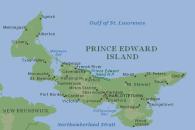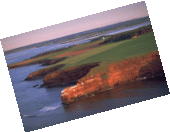Prince Edward Island
The land

Prince Edward Island (P. E. I. ) is Canada's smallest province in both area and population. The crescent-shape island is 224 kilometres in length and ranges in width from 6 to 64 kilometres, giving it a total area of 5 660 km2. It lies in the Gulf of St. Lawrence, separated from Nova Scotia and New Brunswick by Northumberland Strait. Its highest point is 152 metres above sea level. The province has numerous lakes and rivers, most of which are quite small. Rich soil and a temperate climate make Prince Edward Island an ideal place for mixed farming. It is renowned for its red soil, sand dunes and 800 kilometres of beaches.
History
Prince Edward Island was called Abegweit
by the Micmac
Indians, who lived there for some 2 000 years before the arrival of the
Europeans. The name means lying down flat
, but is freely translated as
cradled by the waves
. The Europeans discovered the island when Jacques Cartier landed there in
1534; he described it as the most beautiful stretch of land imaginable
. In
spite of his enthusiastic description, it was a long time before the island
was settled. No permanent colony existed until the French established one in
1719. In 1766, Captain Samuel Holland prepared a topographic map of the island,
then known as the Island of Saint John. In 1769, the Island of Saint John
became a separate colony, and in 1799 it was given its present name,
in honour of Prince Edward of England. Prince Edward Island is known as
the Cradle of Confederation
, since Charlottetown,
its capital, was the site of the 1864 conference that set
Canadian Confederation in motion. This distinction notwithstanding, the
island waited until 1873 to join the Dominion of Canada.

People
The population of Prince Edward Island was approximately 139000 in 2000. Of this number, 62 percent live in the rural districts, including 8 percent on farms. With a population of about 33000, Charlottetown is the largest urban centre. Approximately 75 percent of the people are of British (mainly Scottish and Irish) origin. About 20 percent are of French origin, and nearly five percent speak French. The Aboriginal population of Prince Edward Island numbers approximately 1000. The island population is quite young - about 38 percent of the people are under the age of 25.
Economy
Agriculture, tourism and fishing are the economic mainstays of Prince Edward Island. Prince Edward Island's rich, red soil is ideal for growing potatoes, which are the most important source of income for the province's farms. Although lobster is king of the waters off Prince Edward Island, about 30 other fish and seafood species are caught, notably cultivated mussels, herring, bluefin tuna and the renowned Malpeque oysters. The island's 800 kilometres of beaches attract over 665 000 visitors yearly for relaxation and water sports, including bluefin tuna fishing.
 Source: http://www.gov.pe.ca
Source: http://www.gov.pe.ca

